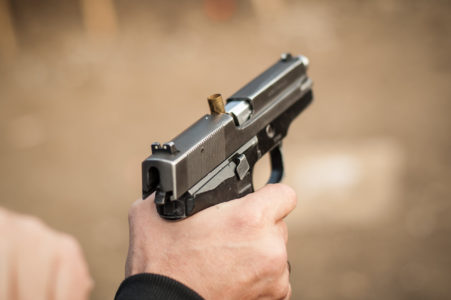CCW Lifestyle Series # 7 – Lockdown Gotcha Down? – Develop Your Dry Fire Practice Routine (Part 3)

Finding productive activities to help survive the stay at home orders can be a challenge. For gun owners, this is a great time to develop your dry fire practice routine.
This is Part 3 of a three part dry practice series. Part 1 addressed setting up a dry practice area and establishing a dry practice routine. Part 1 can be seen here. Part 2, seen here, focused on proper grip, sight picture, and trigger control.
In Part 3 we’ll address clearing three common malfunctions. Typically called Type 1, Type 2, and Type 3, clearing these malfunctions can be readily practiced in a dry fire environment.
As with all things firearms, safety is the primary concern. Setting up and clearing these malfunctions will require dummy ammunition. Never use live ammunition in a dry practice setting. There are many sources for dummy ammunition often called snap caps. These are inert rounds that have the same physical dimensions as live ammunition but are completely inert and cannot fire. Dummunition from Lenny Magill’s GlockStore is one example.
The following will describe the process for setting up and then clearing the malfunctions. This practice should be done in your designated dry practice area and your firearm verified to be unloaded. Once you’ve verified the firearm is unloaded, verify it again. There should be no live ammunition anywhere in your dry practice area.
Type 1 (failure to fire):
- Setup – To set up the Type 1, load several dummy rounds into an empty (verified empty) magazine. Rack the slide and then insert the magazine. You’ll have dummy rounds in the magazine, an empty chamber and the trigger will be reset and ready to fire. Starting from low ready or from the holster, draw and point in getting a good sight picture on the target. Press the trigger and you will hear a click instead of a bang, indicating a malfunction.
- Clearing – Upon hearing the click step to the right or left (getting off the X). While stepping, rotate the firearm so that the ejection port is facing down and solidly tap the bottom of the magazine. The rotate and tap should happen together. After the tap, rack the slide and rotate the gun back into position ending with a dummy round in the chamber, a good sight picture and your finger on the trigger. Start slowly and work against a timer to increase your speed. Clearing a Type 1 malfunction is demonstrated here.
Type 2 (failure to eject or stovepipe):
- Setup – To set up the Type 2, load several dummy rounds into an empty (verified empty) magazine. Lock the slide back. Insert a dummy round partially into the ejection port and slowly move the slide forward trapping the dummy round in the ejection port. Press the trigger to ensure it isn’t reset and insert the magazine. This simulates a stovepipe failure where the spent case does not fully eject and ends up trapped by the slide in the ejection port. Starting from low ready, point in getting a good sight picture on the target. Press the trigger and you will feel no movement, a dead trigger, indicating a malfunction.
- Clearing – Upon feeling the dead trigger, step to the right or left (getting off the X). While stepping, rotate the firearm up slightly and confirm the stovepipe failure. Rotate the firearm so that the ejection port is facing down and solidly tap the bottom of the magazine. The rotate and tap should happen together. After the tap, rack the slide and rotate the gun back into position ending with a dummy round in the chamber, a good sight picture and your finger on the trigger. Start slowly and work against a timer to increase your speed. Clearing a Type 2 malfunction is demonstrated here.
Type 3 (failure to feed or double feed):
- Setup – To set up the Type 3, load several dummy rounds into an empty (verified empty) magazine. Lock the slide back and insert a dummy round into the chamber. Insert the magazine and slowly allow the slide to move forward. This will create a condition where there is a dummy round in the chamber and a second dummy round pressed up behind the first simulating a double feed failure. Press the trigger to ensure it isn’t reset. Starting from low ready, point in getting a good sight picture on the target. Press the trigger and you will feel no movement, a dead trigger, indicating a malfunction.
- Clearing – Upon feeling the dead trigger, step to the right or left (getting off the X). While stepping, rotate the firearm up slightly and confirm the double feed failure. Lock the slide back and strip out the magazine. You can discard the magazine to the ground if you have a fresh magazine (loaded with dummy rounds) on your belt or retain the stripped magazine in your primary hand to be reinserted after clearing the malfunction. Rotate the firearm so that the ejection port is facing down and rack the slide three times clearing the chamber. Reinsert the magazine and rack the slide bringing the gun back into position and with a dummy round in the chamber, a good sight picture and your finger on the trigger. Start slowly and work against a timer to increase your speed. Clearing a Type 3 malfunction is demonstrated here.
Practice clearing these common malfunctions until you can clear each quickly and efficiently. If you get involved in competitive shooting (highly recommended) you’ll get a chance to clear these under time pressure and you’ll be surprised at how naturally you’ll be able to do it.
The right to self-defense is a basic human right. Gun ownership is an integral part of that right. If you want to keep your rights defend them by joining San Diego County Gun Owners (SDCGO) in San Diego, Orange County Gun Owners (OCGO) in Orange County, San Bernardino County Gun Owners (SBCGO) in San Bernardino County or Riverside County Gun Owners (RCGO) in Riverside. Support the cause by listening to Gun Sports Radio live on Sunday afternoon or on the internet at your leisure. Join the fight and help us restore and preserve our second amendment rights. Together we will win.
©2020 Joseph T Drammissi






